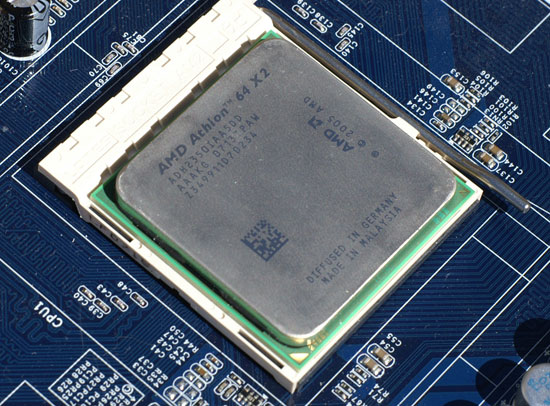Midrange CPU Roundup: It's Time to Buy
by Anand Lal Shimpi on September 28, 2007 2:00 AM EST- Posted in
- CPUs
Understanding the Cheap Chips: AMD's BE Line
One point of continued confusion is AMD's Athlon X2 BE line. The BE processors are regular Athlon 64 X2s but binned for lower power operation, more specifically they all have a 45W TDP compared to 65W for their regular counterparts. Instead of following the same Athlon 64 X2 nomenclature however, the BE chips use an updated model number and naming system, leading to a lot of confusion among customers. As a recap, here's how the BE lineup is named:
Note that AMD has told us that this naming system will probably be phased out in the future, so don't get too attached to the awkward nomenclature. Learn it for now, but know that you'll get to forget it later.

There are two Athlon X2 BE processors, the BE-2350 and BE-2300, running at 2.1GHz and 1.9GHz respectively. Since the architecture remains unchanged, the Athlon X2 BE-2350 performs identically to the Athlon 64 X2 4000+; the 2350 simply runs cooler and costs $18 more.

Because of the performance-parity with the Athlon 64 X2 4000+ we left the BE-2350 out of the performance charts, but we did include it in the power consumption graphs to show you what you're getting for that extra $18.
One point of continued confusion is AMD's Athlon X2 BE line. The BE processors are regular Athlon 64 X2s but binned for lower power operation, more specifically they all have a 45W TDP compared to 65W for their regular counterparts. Instead of following the same Athlon 64 X2 nomenclature however, the BE chips use an updated model number and naming system, leading to a lot of confusion among customers. As a recap, here's how the BE lineup is named:
Format:
The new AMD desktop processor models have an alpha numeric format ofAA-####.
The first letter in Intel's naming system indicates processor class, for example the E6600 vs. X6800. With AMD's new system, we have two letters that describe the class, with the second one being used to indicate TDP. The following four digits in Intel's system simply indicate performance of the processor relative to others in its class; e.g. an E6600 is faster than an E6320, the first digit indicating major performance differences between chips (e.g. E6600 has 4MB L2 cache 1066MHz FSB, while the E4300 has a 2MB L2 cache and 800MHz FSB). AMD's system is similar: the first digit is reserved for major differences in performance and the latter three digits are used for minor differences (think speed bins).
Note that AMD has told us that this naming system will probably be phased out in the future, so don't get too attached to the awkward nomenclature. Learn it for now, but know that you'll get to forget it later.

There are two Athlon X2 BE processors, the BE-2350 and BE-2300, running at 2.1GHz and 1.9GHz respectively. Since the architecture remains unchanged, the Athlon X2 BE-2350 performs identically to the Athlon 64 X2 4000+; the 2350 simply runs cooler and costs $18 more.

Because of the performance-parity with the Athlon 64 X2 4000+ we left the BE-2350 out of the performance charts, but we did include it in the power consumption graphs to show you what you're getting for that extra $18.










44 Comments
View All Comments
Darth Farter - Friday, September 28, 2007 - link
why not the cool & quiet idle power numbers?seeing they're running at full speeds at idle is besides the point of an "idle" measurement in this age with powersavings...
tnx though on the bios update request from asus... I want to tweak my timings too.
Anand Lal Shimpi - Friday, September 28, 2007 - link
C&Q and EIST were both enabled for the idle and load power numbers. Actually all the benchmarks were run with those settings enabled.Take care,
Anand
archcommus - Friday, September 28, 2007 - link
I realize the benchmarks are run at 1024x768 to make the tests CPU-limited, does that mean all, or at least most, of the extra horsepower needed for resolutions above that comes from the GPU? If so, does that mean I could run games at 1280x1024 well with a high-end card and one of the AMD CPUs from this round-up? Or would that be a bad match-up? If that would work it's an appealing upgrade path alternative to jumping platforms.nosfe - Friday, September 28, 2007 - link
why not color code those performance graphs so that we can easily see which processors are competing at the same price